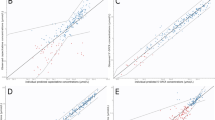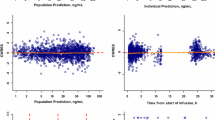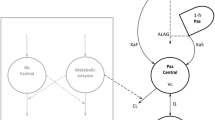Abstract
Purpose: The aims of the study were (a) to characterise the pharmacokinetics (PK), including inter-individual variability (IIV) and inter-occasion variability (IOV) as well as covariate relationships and (b) to characterise the relationship between the PK and the haematological toxicity of the component drugs of the fluorouracil (5-FU)—epirubicin (EPI)—cyclophosphamide (CP) regimen in breast cancer patients. Patients and methods: Data from 140 breast cancer patients, either within one of different studies or in routine clinical management, were included in the analyses. The patients were all treated with the fluorouracil-epirubicin-cyclophosphamide (FEC) regimen every third week for 3–12 courses, either in standard doses, i.e. 600/60/600 mg/m2 of 5-FU, EPI and CP, respectively, or according to a dose escalation/reduction protocol (tailored dosing). PK data were available from 84 of the patients, whereas time-courses of haematological toxicity were available from 87 patients. The data analysis was carried out using mixed effects models within the NONMEM program. Results: The PK of 5-FU, EPI and 4-hydroxy-cyclophosphamide (4-OHCP), the active metabolite of CP, were described with a one-compartment model with saturable elimination, a three-compartment linear model and a two-compartment linear model, respectively. No clinical significant correlation was found between PK across drugs. The unexplained variability in clearance was found to be less within patients, between courses (inter-occasion variability, IOV) than between patients (inter-individual variability, IIV) for EPI and 5-FU. For 4-OHCP, however, the IIV diminished by approximately 45% when significant covariates were included and the final population model predicts an IIV that is equal to IOV. Significant covariates for elimination capacity parameters were serum albumin (5-FU, EPI and 4-OHCP), creatinine clearance (5-FU), bilirubin (EPI) and body surface area (BSA) (4-OHCP). Elimination capacity of 5-FU and EPI was not related to BSA and for none of the studied drugs did body weight explain the PK variability. The time-course of haematological toxicity after treatment was well described by a semi-physiological model that assumes additive haematological toxicity between CP and EPI with negligible contribution from 5-FU. The influence of G-CSF could be incorporated into the model in a mechanistic manner as shortening the maturation time to 43% of the normal duration and increasing the mitotic activity to 269% of normal activity. Conclusions: The models presented describe the dose-concentration-toxicity relationships for the FEC therapy and may provide a basis for implementation and comparison of different individualisation strategies based on covariates, therapeutic drug monitoring and/or pharmacodynamic (PD) feedback. The PD model extends on previous semi-mechanistic models in that it also takes G-CSF administration into account.




Similar content being viewed by others
References
Beal S, Sheiner L (1999) NONMEM users guides. University of California, San Fransicso, CA
Bergh J, Wiklund T, Erikstein B, Fornander T, Bengtsson NO, Malmstrom P, Kellokumpu-Lehtinen P, Anker G, Bennmarker H, Wilking N (1998) Dosage of adjuvant G-CSF (filgrastim)-supported FEC polychemotherapy based on equivalent haematological toxicity in high-risk breast cancer patients. Scandinavian Breast Group, Study SBG 9401. Ann Oncol 9:403
Bergh J, Wiklund T, Erikstein B, Lidbrink E, Lindman H, Malmstrom P, Kellokumpu-Lehtinen P, Bengtsson NO, Soderlund G, Anker G, Wist E, Ottosson S, Salminen E, Ljungman P, Holte H, Nilsson J, Blomqvist C, Wilking N (2000) Tailored fluorouracil, epirubicin, and cyclophosphamide compared with marrow-supported high-dose chemotherapy as adjuvant treatment for high-risk breast cancer: a randomised trial. Scandinavian Breast Group 9401 study. Lancet 356:1384
Cockroft D, Gault M (1976) Prediction of creatinine clearance from serum creatinine. Nephron 16:31
De Bruijn EA, Driessen OM, Hermans J (1991) The CMF-regimen. Toxicity patterns following stepwise combinations of cyclophosphamide, methotrexate and fluorouracil. Int J Cancer 48:67
Del Mastro L, Venturini M, Lionetto R, Carnino F, Guarneri D, Gallo L, Contu A, Pronzato P, Vesentini L, Bergaglio M, Comis S, Rosso R (2001) Accelerated-intensified cyclophosphamide, epirubicin, and fluorouracil (CEF) compared with standard CEF in metastatic breast cancer patients: results of a multicenter, randomized phase III study of the Italian gruppo oncologico nord-ouest-mammella inter gruppo group. J Clin Oncol 19:2213
Diasio RB, Harris BE (1989) Clinical pharmacology of 5-fluorouracil. Clin Pharmacokinet 16:215
Dobbs NA, Twelves CJ, Gregory W, Cruickshanka C, Richards MA, Rubens RD (2003) Epirubicin in patients with liver dysfunction: development and evaluation of a novel dose modification scheme. Eur J Cancer 39:580
Evans WE, Relling MV (1989) Clinical pharmacokinetics-pharmacodynamics of anticancer drugs. Clin Pharmacokinet 16:327
Evans WE, Relling MV, Rodman JH, Crom WR, Boyett JM, Pui CH (1998) Conventional compared with individualized chemotherapy for childhood acute lymphoblastic leukemia. N Engl J Med 338:499
Extra JM, Rousseau F, Bruno R, Clavel M, Le Bail N, Marty M (1993) Phase I and pharmacokinetic study of Taxotere (RP 56976; NSC 628503) given as a short intravenous infusion. Cancer Res 53:1037
Fleming RA, Milano G, Thyss A, Etienne MC, Renee N, Schneider M, Demard F (1992) Correlation between dihydropyrimidine dehydrogenase activity in peripheral mononuclear cells and systemic clearance of fluorouracil in cancer patients. Cancer Res 52:2899
Fossati R, Confalonieri C, Torri V, Ghislandi E, Penna A, Pistotti V, Tinazzi A, Liberati A (1998) Cytotoxic and hormonal treatment for metastatic breast cancer: a systematic review of published randomized trials involving 31,510 women. J Clin Oncol 16:3439
Freyer G, Tranchand B, Ligneau B, Ardiet C, Souquet PJ, Court-Fortune I, Riou R, Rebattu P, Boissel JP, Trillet-Lenoir V, Girard P (2000) Population pharmacokinetics of doxorubicin, etoposide and ifosfamide in small cell lung cancer patients: results of a multicentre study. Br J Clin Pharmacol 50:315
Friberg LE, Henningsson A, Maas H, Nguyen L, Karlsson MO (2002) Model of chemotherapy-induced myelosuppression with parameter consistency across drugs. J Clin Oncol 15, 20(24):4713
Gamelin E, Boisdron-Celle M, Guerin-Meyer V, Delva R, Lortholary A, Genevieve F, Larra F, Ifrah N, Robert J (1999) Correlation between uracil and dihydrouracil plasma ratio, fluorouracil (5-FU) pharmacokinetic parameters, and tolerance in patients with advanced colorectal cancer: A potential interest for predicting 5-FU toxicity and determining optimal 5-FU dosage. J Clin Oncol 17:1105
Grochow LB, Noe DA, Dole GB, Rowinsky EK, Ettinger DS, Graham ML, McGuire WP, Donehower RC (1989) Phase I trial of trimetrexate glucuronate on a five-day bolus schedule: clinical pharmacology and pharmacodynamics. J Natl Cancer Inst 81:124
Grochow LB, Baraldi C, Noe D (1990) Is dose normalization to weight or body surface area useful in adults? J Natl Cancer Inst 82:323
Gurney H (1996) Dose calculation of anticancer drugs: a review of the current practice and introduction of an alternative. J Clin Oncol 14:2590
Gurney HP, Ackland S, Gebski V, Farrell G (1998) Factors affecting epirubicin pharmacokinetics and toxicity: evidence against using body-surface area for dose calculation. J Clin Oncol 16:2299
Hansen RM, Ryan L, Anderson T, Krzywda B, Quebbeman E, Benson A III, Haller DG, Tormey DC (1996) Phase III study of bolus versus infusion fluorouracil with or without cisplatin in advanced colorectal cancer. J Natl Cancer Inst 88:668
Henderson IC, Hayes DF, Gelman R (1988) Dose-response in the treatment of breast cancer: a critical review. J Clin Oncol 6:1501
Jakobsen P, Bastholt L, Dalmark M, Pfeiffer P, Petersen D, Gjedde SB, Sandberg E, Rose C, Nielsen OS, Mouridsen HT (1991) A randomized study of epirubicin at four different dose levels in advanced breast cancer. Feasibility of myelotoxicity prediction through single blood-sample measurement. Cancer Chemother Pharmacol 28:465
Jonsson EN, Karlsson MO (1998) Automated covariate model building within NONMEM. Pharm Res 15:1463
Karlsson MO, Sheiner LB (1993) The importance of modeling interoccasion variability in population pharmacokinetic analyses. J Pharmacokinet Biopharm 21:735
Kwon CH, Maddison K, LoCastro L, Borch RF (1987) Accelerated decomposition of 4-hydroxycyclophosphamide by human serum albumin. Cancer Res 47:1505
Leichman CG, Fleming TR, Muggia FM, Tangen CM, Ardalan B, Doroshow JH, Meyers FJ, Holcombe RF, Weiss GR, Mangalik A et al (1995) Phase II study of fluorouracil and its modulation in advanced colorectal cancer: a Southwest Oncology Group study. J Clin Oncol 13:1303
Levine MN, Bramwell VH, Pritchard KI, Norris BD, Shepherd LE, Abu-Zahra H, Findlay B, Warr D, Bowman D, Myles J, Arnold A, Vandenberg T, MacKenzie R, Robert J, Ottaway J, Burnell M, Williams CK, Tu D (1998) Randomized trial of intensive cyclophosphamide, epirubicin, and fluorouracil chemotherapy compared with cyclophosphamide, methotrexate, and fluorouracil in premenopausal women with node-positive breast cancer. National Cancer Institute of Canada Clinical Trials Group. J Clin Oncol 16:2651
Lokich JJ, Ahlgren JD, Gullo JJ, Philips JA, Fryer JG (1989) A prospective randomized comparison of continuous infusion fluorouracil with a conventional bolus schedule in metastatic colorectal carcinoma: a mid-Atlantic oncology program study. J Clin Oncol 7:425
Microsoft Excel 2000 (1999) Microsoft Corporation
Milano G, Etienne MC (1994) Potential importance of dihydropyrimidine dehydrogenase (DPD) in cancer chemotherapy. Pharmacogenetics 4:301
Moore MJ, Theissen JJ (1992) Cytotoxics and irreversible effects. In: van Boxtel CJ, Holford NHG, Danhof M (eds) The in vivo study of drug action. Elsevier Science Publisher B. V., Amsterdam, p 377
Moore MJ, Erlichman C, Thiessen JJ, Bunting PS, Hardy R, Kerr I, Soldin S (1994) Variability in the pharmacokinetics of cyclophosphamide, methotrexate and 5-fluorouracil in women receiving adjuvant treatment for breast cancer. Cancer Chemother Pharmacol 33:472
Plosker GL, Faulds D (1993) Epirubicin. A review of its pharmacodynamic and pharmacokinetic properties, and therapeutic use in cancer chemotherapy. Drugs 45:788
Ralph LD, Thomson AH, Dobbs NA, Twelves C (2003) A population model of epirubicin pharmacokinetics and application to dosage guidelines. Cancer Chemother Pharmacol 52:34
Riccardi A, Giordano M, Brugnatelli S, Ucci G, Danova M, Mora O, Fava S, Ascari E (1995) Different doses of epirubicin associated with fixed doses of cyclophosphamide and 5-fluorouracil: a randomised study in advanced breast cancer (letter). Eur J Cancer 31A:1549
Robert J (1994) Clinical pharmacokinetics of epirubicin. Clin Pharmacokinet 26:428
Rodman JH, Abromowitch M, Sinkule JA, Hayes FA, Rivera GK, Evans WE (1987) Clinical pharmacodynamics of continuous infusion teniposide: systemic exposure as a determinant of response in a phase I trial. J Clin Oncol 5:1007
Rodman JH, Relling MV, Stewart CF, Synold TW, McLeod H, Kearns C, Stute N, Crom WR, Evans WE (1993) Clinical pharmacokinetics and pharmacodynamics of anticancer drugs in children. Semin Oncol 20:18
Sandstrom M, Freijs A, Larsson R, Nygren P, Fjallskog ML, Bergh J, Karlsson MO (1996) Lack of relationship between systemic exposure for the component drug of the fluorouracil, epirubicin, and 4-hydroxycyclophosphamide regimen in breast cancer patients. J Clin Oncol 14:1581
Sandstrom M, Lindman H, Nygren P, Lidbrink E, Bergh J, Karlsson MO (2005) Haematological toxicity of the epirubicin-docetaxel regimen in breast cancer patients. J Clin Onc 23:413
Sawyer M, Ratain MJ (2001) Body surface area as a determinant of pharmacokinetics and drug dosing. Invest New Drugs 19:171
Simonsen LE, Wahlby U, Sandstrom M, Freijs A, Karlsson MO (2000) Haematological toxicity following different dosing schedules of 5-fluorouracil and epirubicin in rats. Anticancer Res 20:1519
Terret C, Erdociain E, Guimbaud R, Boisdron-Celle M, McLeod HL, Fety-Deporte R, Lafont T, Gamelin E, Bugat R, Canal P, Chatelut E (2000) Dose and time dependencies of 5-fluorouracil pharmacokinetics. Clin Pharmacol Ther 68:270
Twelves CJ, Dobbs NA, Michael Y, Summers LA, Gregory W, Harper PG, Rubens RD, Richards MA (1992) Clinical pharmacokinetics of epirubicin: the importance of liver biochemistry tests. Br J Cancer 66:765
Van der Wall E, Rutgers EJ, Holtkamp MJ, Baars JW, Schornagel JH, Peterse JL, Beijnen JH, Rodenhuis S (1996) Efficacy of up-front 5-fluorouracil-epidoxorubicin-cyclophosphamide (FEC) chemotherapy with an increased dose of epidoxorubicin in high-risk breast cancer patients. Br J Cancer 73:1080
Venturini M, Del Mastro L, Testore F, Danova M, Garrone O, Lanfranco C, Latini F, Sertoli MR, Lionetto R, Queirolo P, Ardizzoni A, Rosso R (1996) Erythropoietin and granulocyte-macrophage colony-stimulating factor allow acceleration and dose escalation of cyclophosphamide/epidoxorubicin/5-fluorouracil chemotherapy: a dose-finding study in patients with advanced breast cancer. Cancer Chemother Pharmacol 38:487
Yule SM, Boddy AV, Cole M, Price L, Wyllie R, Tasso MJ, Pearson AD, Idle JR (1995) Cyclophosphamide metabolism in children. Cancer Res 55:803
Acknowledgements
First of all we want to thank the patients for participating. We also want to thank Britt Jansson, Malin Johansson, Therese Bäckman, Josefin Ahnström, Malin Lundström, Rita Grönberg, Tina Fornbrandt, Carina Andersson and Leif Astner for assistance in different parts and phases of the work, and the Swedish Cancer Society for financial support.
Author information
Authors and Affiliations
Corresponding author
Rights and permissions
About this article
Cite this article
Sandström, M., Lindman, H., Nygren, P. et al. Population analysis of the pharmacokinetics and the haematological toxicity of the fluorouracil-epirubicin-cyclophosphamide regimen in breast cancer patients. Cancer Chemother Pharmacol 58, 143–156 (2006). https://doi.org/10.1007/s00280-005-0140-2
Received:
Accepted:
Published:
Issue Date:
DOI: https://doi.org/10.1007/s00280-005-0140-2




